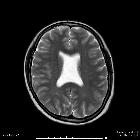absence of septum pellucidum














An absent septum pellucidum may rarely be an isolated finding, or more commonly be seen in association with a variety of conditions.
Epidemiology
The septum pellucidum is partly or entirely absent in 2 or 3 individuals per 100,000 in the general population.
Pathology
An absent septum pellucidum may be developmental or acquired secondary to another pathological process .
Cavum septum pellucidum is always visualized between 18 and 37 weeks and within a biparietal diameter of 44 to 88 mm. Failure to detect the cavum septum pellucidum within this time interval requires further investigation. However, the absence of cavum septum pellucidum on the ultrasound exam prior to 18 weeks or later than 37 weeks is considered a normal finding.
Developmental
- isolated
- corpus callosum agenesis
- holoprosencephaly
- AVID syndrome
- septo-optic dysplasia
- schizencephaly
Acquired
Radiographic features
Non-visualization of the septum pellucidum with direct communication of the frontal horns. Additionally, the following characteristics may be seen :
- boxing/squaring off of the frontal horns
- inferior pointing frontal horns
- abnormally inferiorly positioned fornix (coronal views)
Siehe auch:
und weiter:

 Assoziationen und Differentialdiagnosen zu fehlendes Septum pellucidum:
Assoziationen und Differentialdiagnosen zu fehlendes Septum pellucidum:

